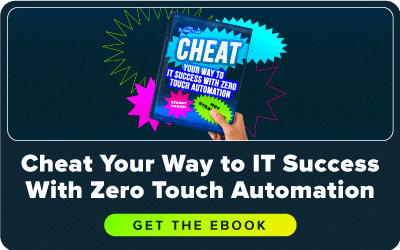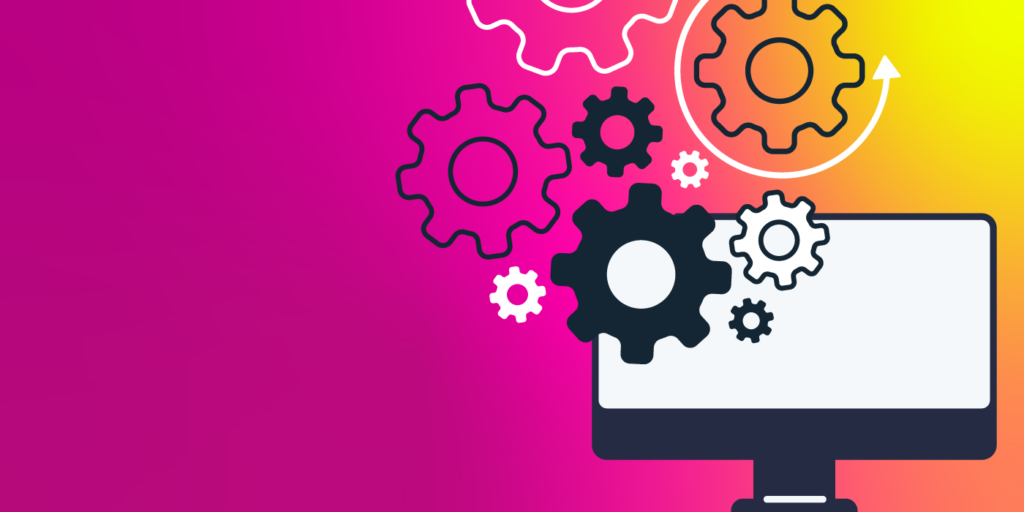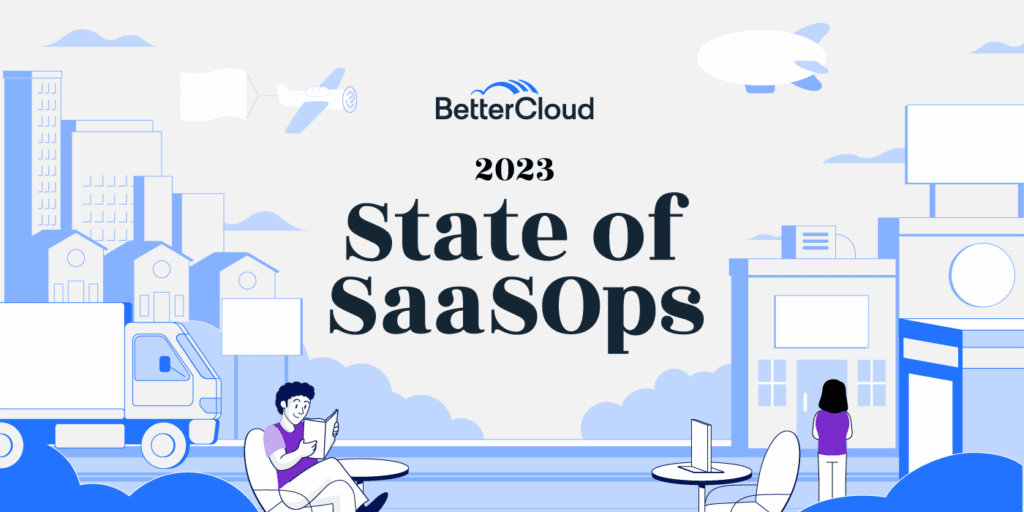How We Use BetterCloud At BetterCloud to Deliver a Zero-Touch Employee Experience
April 21, 2022
8 minute read
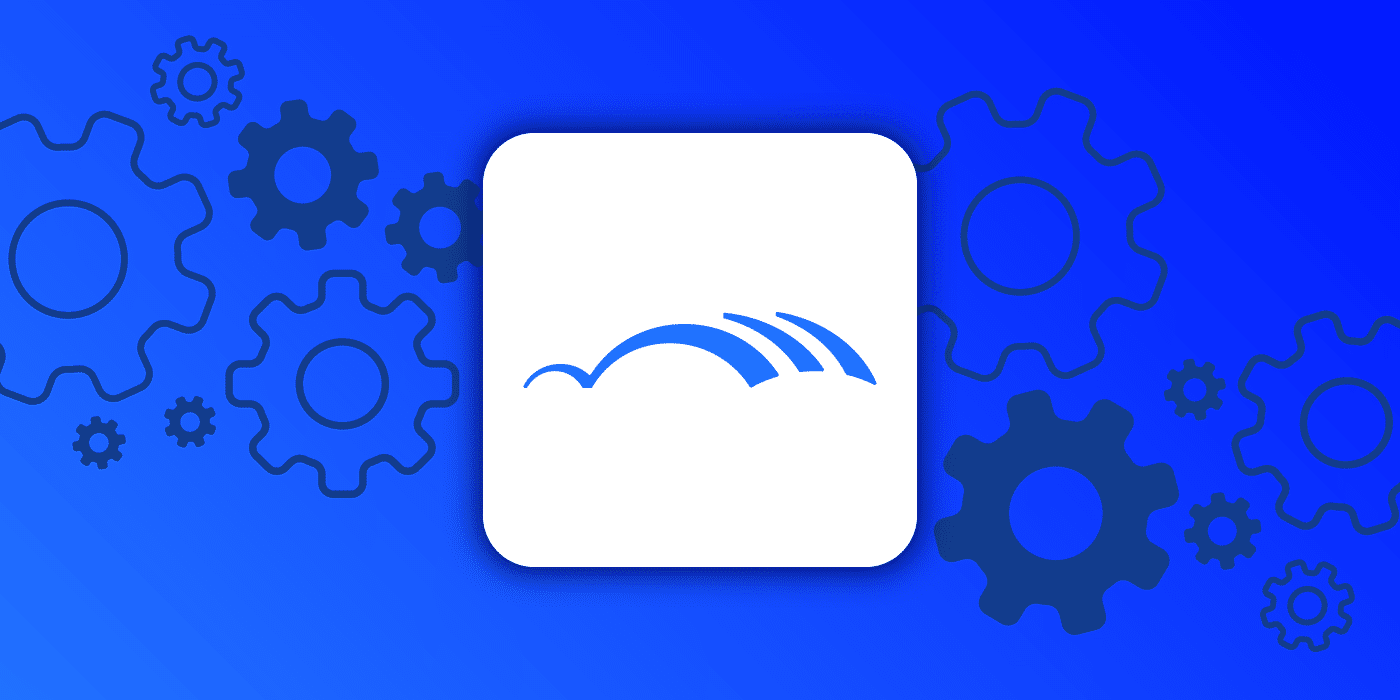
Over the past decade, technology has changed the way a lot of us work. Oddly enough, this doesn’t apply to most IT departments.
Although remote work has evolved into just work for so many people, IT pros still do most of their jobs manually. All too often, they get buried under endless (digital) piles of help desk tickets. They jump between hundreds of tabs to grant and revoke app access. And to ensure that everyone has the hardware they need to do their jobs, they run shipping departments out of their own homes.
If you’re reading this post, you probably know that this needs to change. Remote work has changed how and when we work. Most of us can think of at least a dozen times when we stepped away for an afternoon to pick up our kids from school, to do a mid-afternoon workout, or just to catch up on the latest Netflix miniseries. Work days have become non-linear—and asynchronous work is just work in 2022.
Remote work has also changed how we work, but it has also changed your users’ expectations. Even if your IT department is based on the East Coast, employees on the West Coast expect to get the tools they need as quickly as they can hail an Uber in 2022. Oh yeah, and if you deliver a less-than-stellar employee experience, your best people won’t have trouble finding new jobs.
These are just a few reasons why businesses around the world are embracing a zero-touch IT mindset to deliver a best-in-class employee experience and elevate IT. That includes us! We’ve talked about many of these tips in previous posts, but here’s one place where you can read about how we’re moving towards zero-touch IT at BetterCloud, with BetterCloud.

Zero-touch hardware procurement (and provisioning)
Most of us can’t do a job without a computer, right? Even if your onboarding process is bad, I’m willing to bet that the first step of said process is to procure hardware for new hires.
But like most things, doing so manually makes things unnecessarily difficult. Here are just a few realities of manual hardware provisioning:
- Lots of time wasted running updates (about 30-45 minutes per computer, according to our IT folks)
- Uncertainty & delays on when new hires could start
- Doubled cost of shipping
- Slower new hire starts = slower ramp up = less success
Those are a lot of words to describe an already cumbersome process. If you like charts, here’s one that outlines the pain of manual hardware provisioning:
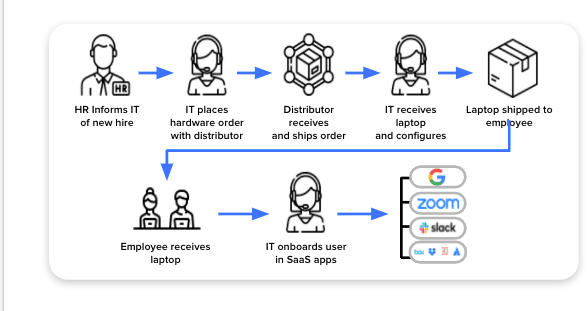
To remedy this, our IT team recently set off on a mission to improve everyone’s quality of life by enabling a true zero-touch onboarding experience. For those of you who like images, here’s how hardware procurement works at BetterCloud.
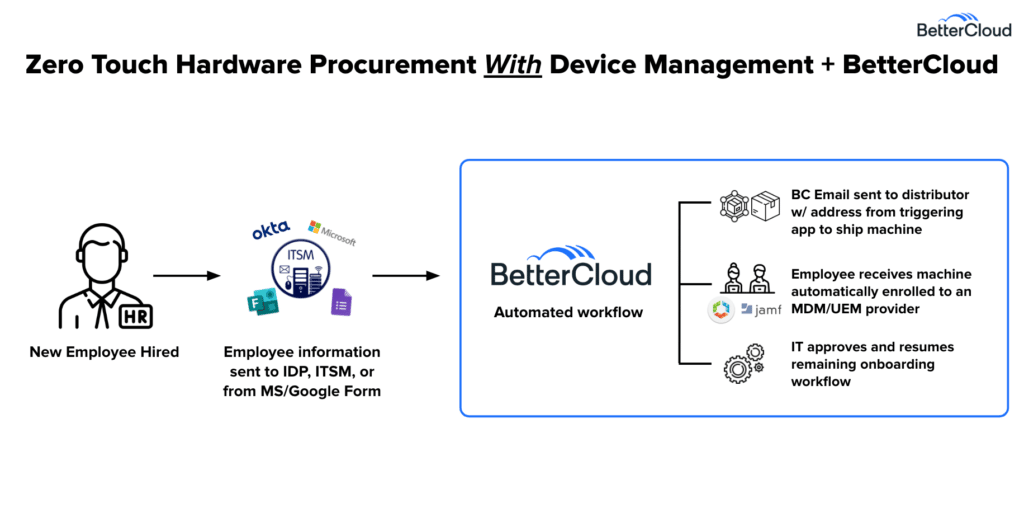
Let’s talk about what’s happening here:
- When a candidate is hired, our wonderful People team submits a Google form that includes that person’s name, their address, and the type of computer they’ve selected
- Once the form is submitted, an automated workflow in BetterCloud sends an email to our distributor and places an order for a computer
- The new employee receives a computer that’s already enrolled in an MDM (in our case, Jamf)
- IT gives that new user the green light and the automated workflow continues granting access to the apps that person needs
- Brian Farrell and Dennis Irizarry no longer have to do this all manually and get to enjoy cocktails after work
I know what you’re thinking. “Rich, you did a lot of writing to explain this. How is this zero-touch hardware procurement?” And I get it. But check out this video to see the workflow in action. Spoiler: It’s not very long.

Zero-touch role changes across your entire organization
In a previous post, we talked about the drudgery of employee transfers. A single move from one team to another means removing and granting access to an endless list of new applications, not to mention all the groups you need to move that person into and out of. Multiply that by even just 10 employees and IT suddenly has a nightmare filled with manual tasks on its hands, all of which are prone to human error because nobody’s perfect when you have 1,000 tabs open at the same time.
But as you might have guessed by now, you can automate app provisioning and deprovisioning with workflows that run when IT moves users into and out of Org Units in Google Workspace. In case you missed that post and don’t feel like clicking away from this one, here’s a quick refresher:

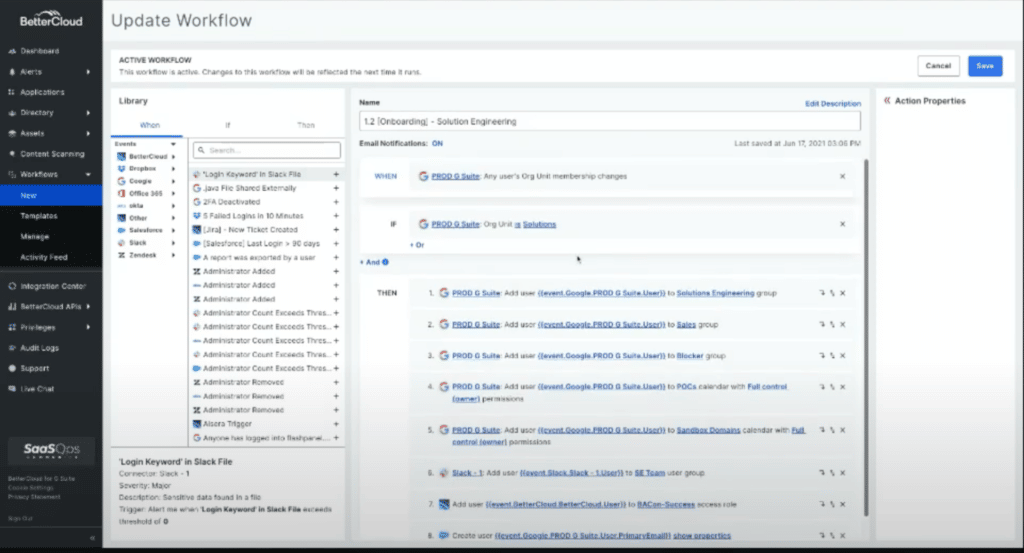
What the heck is happening here? Here’s a quick breakdown:
- Removing a user from the Marketing Org Unit triggers the marketing offboarding workflow, which removes that person from marketing-specific Slack channels and revokes access to applications like Asana
- When IT adds that person to the Solution Engineering Org Unit, BetterCloud runs the solution engineering onboarding workflow, which grants access to relevant groups, Slack channels, and additional apps they need to do their job
Isn’t it wild how much you can get done just by moving a user from one Org Unit to another? The images above cover just one example of an internal transfer that we use BetterCloud to process. Our IT team uses an additional 150 zero-touch IT workflows to handle any internal transfer, promotion, or departure seamlessly.

I know what you’re thinking: Why did BetterCloud’s IT team put itself through the torture of thinking through and building these workflows?
The short answer is that research shows that new hires who have a positive experience are more likely to contribute to business goals and remain with their employer. Additionally, organizations with a strong onboarding process improve new hire retention by 82% and productivity by over 70%.
That’s probably convincing enough data to automate your onboarding and offboarding processes. But can you use BetterCloud to automate help desk tickets? Of course. We wouldn’t have asked this hypothetical question if you couldn’t. Here’s how we do it.
Using chatbots to resolve help desk tickets
Last year, our IT team resolved thousands of help desk tickets. And get this: The median resolution time was just under 12 hours, with 62% of tickets resolved within 24 hours.
How do we do it at BetterCloud? We have teams of IT admins who sit around and do nothing but respond to help desk tickets all day. Just kidding. In addition to the zero-touch IT workflows we’ve already discussed in this post, our IT team is testing out a chatbot that will enable us to request and gain app access from Slack.
Editor’s note: This is the part where I’m required to tell you this is still in testing. We haven’t rolled this out yet, so please hold all questions for Brian Farrell and Rudy Fraser until further notice, or I’m going to be in big trouble.
Want to see how it works? I thought so. In the image below, you’ll see that the user has typed the words “I need access to an app” into the chatbot. The chatbot responds by adding an emoji reaction to the message to acknowledge the request was received, then replies with a dropdown menu of applications for the user to select from.
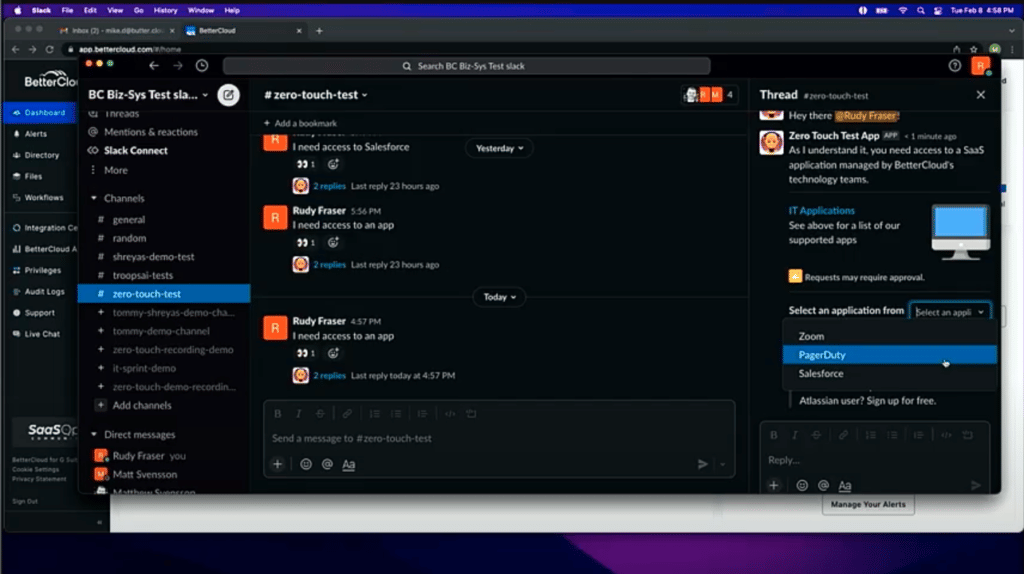
Once you confirm that you want access to the application you’ve selected, IT receives an email notifying the team that you’ve used the chatbot to request access.
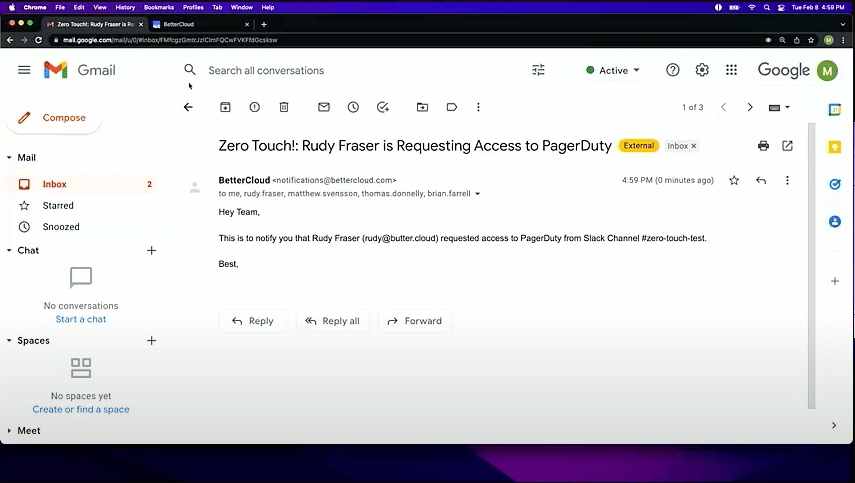
Neat, right? How did we do it? Was it a little Python script running in the background? Nope! We extended BetterCloud’s platform support for the apps that aren’t available in our Integration Center (in this case, PagerDuty). These extensions listen for events such as a ticket submission, or in this case, a message sent to our chatbot.
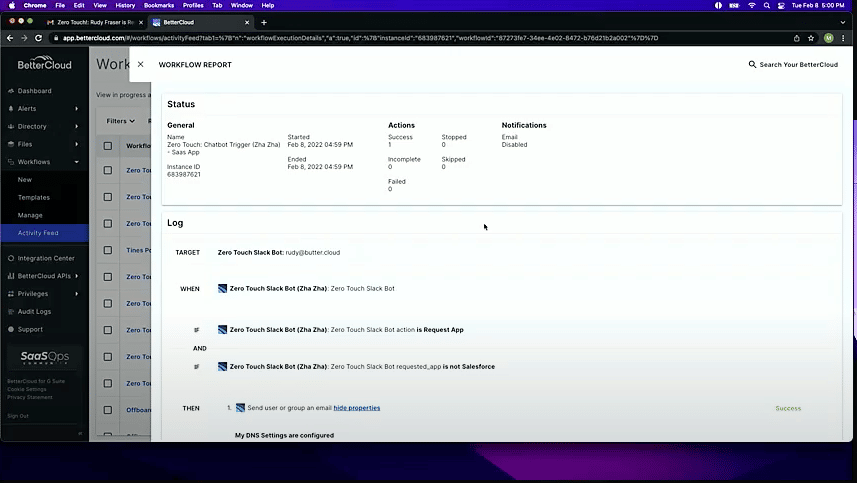
This one’s pretty simple and ends with a notification to the IT team, but you can also configure this workflow to find additional details from the user or even provision access to the application.
Oh yeah, we won’t be restricted to just requesting access from this chatbot. In the screenshot below, you’ll see that our IT team is testing a feature that would allow employees to reset their Okta MFA.

A lot is happening in the background here, but this entire chatbot is powered by one extension of BetterCloud’s platform that’s listening for a large list of actions. Again, this is still in the works—but I think you’ll be pretty jealous of everyone at BetterCloud once it’s live.
Zero-touch offboarding with BetterCloud
When you’re done begging (er, asking) your colleagues to reconsider, offboarding can quickly become a huge mess for IT. There’s application access you need to revoke (and revoke fully). There are the files and calendars you need to either delete or transfer to that person’s hiring manager. There’s a long list of people you need to notify when these tasks are complete. And don’t get us started if someone makes a mistake along the way, right?
At the risk of sounding like a late-night infomercial, what if I told you that you could do all of these tasks with a workflow? Here’s what that looks like for BetterCloud’s IT team.
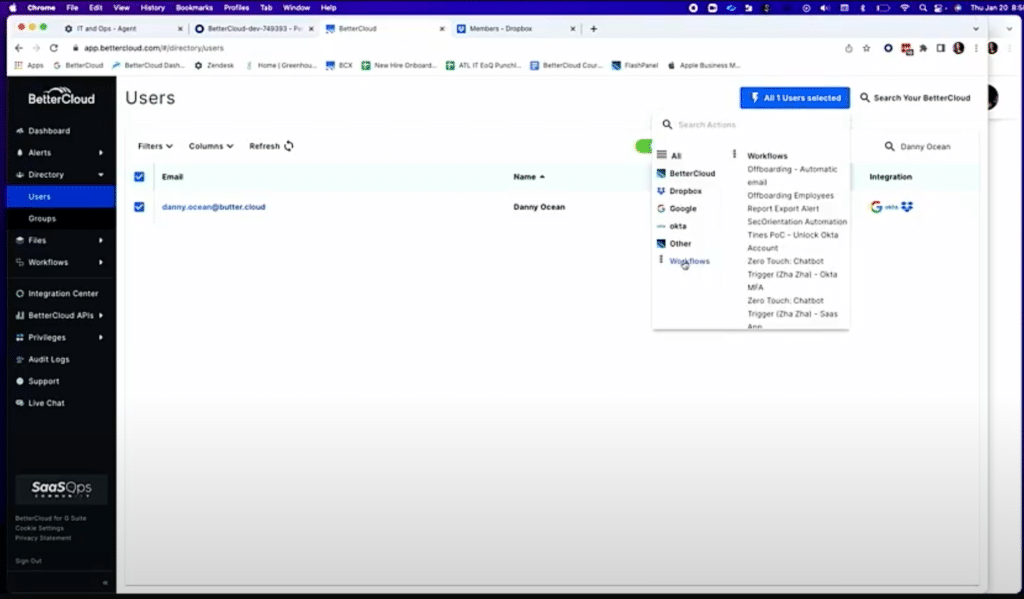
All our IT folks need to do to revoke app access from a departing employee is run an offboarding workflow they’ve built. But offboarding doesn’t necessarily stop at deprovisioning app access. What do you do with all of your former employee’s documents and calendar events? Transfer each item to a manager individually? Nobody has time for that.
Instead, the IT team at BetterCloud built a workflow that handles all those transfers—and all you need to do is move the former employee to a dedicated Org Unit they’ve named “Deprovision.”

As you can see in the image above, the automated workflow handles everything from setting auto-replies from the former employee’s inbox to transferring ownership of groups, calendars, and files to that person’s manager.
To put this time savings in perspective, I have 10GB of files in my Google Drive right now. If I were ever to leave this company, that would be a nightmare for someone to transfer to my boss, file by file.
Multiply that amount of work by just five employees and it’s not difficult to see how much of a headache this workflow saves our IT team from.
As we’ve said several times on this blog, we’ve only scratched the surface of how a zero-touch IT mindset can help you deliver a best-in-class employee experience. At the same time, the “beginning” of our movement towards a self-service environment has freed up our IT friends to focus on more strategic initiatives that are enabling people like me to meet my goals.
Want to learn more about how you can use BetterCloud to create a best-in-class zero-touch employee experience? Check out the resources below.




